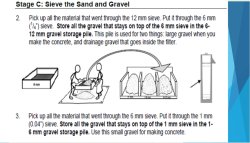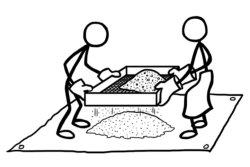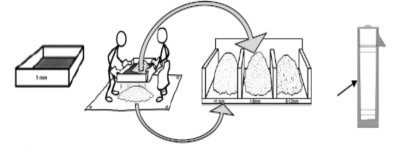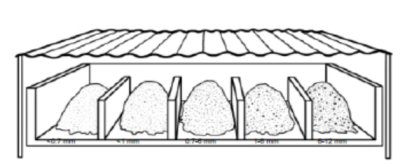
|
 Contact UsEen Druppeltje Hoop
Groeien en GaanDrop of Hope School ProjectKinder EvangelisatieKids Discipleship TrainingAfrican Countries SelectedCARICOM Countries SelectedHumanitarian ArmUCT Leerplan |
thuis >>production site>> sand and gravel>> sieve sand and gravel Production Site sieve sand and gravel Embedded Microsoft Office presentation, powered by Office.
Concrete sand and gravel (for making the container)
Sieves (3 sizes):
|
|
2. Pick up all the material that went through the 12 mm sieve. Put it through the 6 mm (1/4") sieve. Store all the gravel that stays on top of the 6 mm sieve in the 6- 12 mm gravel storage pile. This pile is used for two things: large gravel when you make the concrete, and drainage gravel that goes inside the filter.
3. Pick up all the material that went through the 6 mm sieve. Put it through the 1 mm (0.04") sieve . Store all the gravel that stays on top of the 1 mm sieve in the 1- 6 mm gravel storage pile. Use this small gravel for making concrete.
4. Store all the sand that fell through the 1 mm sieve in the <1 mm sand storage pile. Use this sand for making concrete Concrete sand and gravel (for inside the filter) 1. Put the sand and gravel through the 12 mm (1/2") sieve. Throw away any rocks that stay on top of the 12 mm sieve-they are too big to use in the BioSand Filter. It may get very dusty. Wear a dust mask or scarf. 2. Pick up all the material that went through the 12 mm sieve. Put it through the 6 mm (1/4") sieve. Store all the gravel that stays on top of the 6 mm sieve in the 6- 12mm gravel storage pile. This pile is used for two things: large gravel when you make the concrete and drainage gravel that goes inside the filter. 3. Pick up all the material that went through the 6 mm sieve. Put it through the 0.7 mm (0.03") sieve. Store all the gravel that stays on top of the 0.7 mm sieve in the 0.7-6mm gravel storage pile. This is the separation gravel for inside the filter. 4. Store all the sand that fell through the 0.7 mm sieve in the <0.7 mm sand storage pile. This is the filtration sand for inside the filter.
Tips for sieving the sand and gravel
Store the sieved sand and gravel · Store the piles of sieved sand and gravel where they will stay clean and dry. · Make sure you keep your piles tidy and separate so that they do not mix with each other or with un-sieved sand. Simple storage area : Piles of sand and gravel are separated by pieces of wood. The ground is covered by a tarp or plastic sheet. It is easy for sand and gravel to get mixed, so be very careful. Improved storage area: Piles of sand and gravel are separated by tall concrete walls. Floor is concrete. This storage area helps to keep the piles separated. You do not have to store all the sand and gravel piles in the same location. You can store the concrete sand and gravel near the filter pouring area, and the filtration sand and gravel near the area for washing sand and gravel. Download English Handbook #7 Stage C: Sieve the Sand and Gravel Learn how to Wash the Filtration Sand and Gravel
|
| Copyright © 2024 www.UnitedCaribbean.com. All rights reserved. Disclaimer Click to Contact us |























































